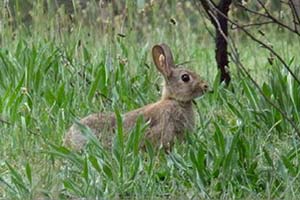Rabbit control program

Rabbit control helps to protect the ACT’s environmental values, primary production, and urban landscapes.
Through selective grazing, rabbits impact regeneration and recruitment of native plants, cause soil erosion, and facilitate the spread of weeds.
Management policy
The Pest Animal Management Strategy 2012-22 was released by the Minister for the Environment and Sustainable Development on 26 July 2012.
The ACT Government has developed a Best Practice Management Guide for Rabbits to support control efforts in accordance with the national Code of Practice for the Humane Control of Rabbits. The guide provides information on the damage that rabbits cause, rabbit control methods and associated risks, key principles of best practice management and examples of where they have been successfully applied in ACT Government rabbit control programs.
Management tools
Acceptable rabbit thresholds are set based on vegetation type and aim to minimise negative impacts such as selective grazing of native vegetation.
The ACT Government undertakes a range of actions to manage rabbits, including exclusion fencing, shooting, lethal baiting, harbor destruction, diffusion fumigation, trapping, and rabbit haemorrhagic disease virus. Techniques are carried out in accordance with Codes of Practice which can be found on the Pestsmart website.
Population densities
Before control techniques are employed, monitoring is required to determine rabbit population densities, assess actual or potential damage levels, determine the location, extent and activity of warrens, identify potential impacts on non-target species and the environment, and set the objectives and targets for the management program.
Population estimates are gathered through spotlighting counts along transects, warren counts, active entrance counts, and warren mapping. Each of these techniques are described in the ACT Government Best Practice Management Guide for Rabbits.
Animal welfare
ACT Government rabbit control operations are carried out in accordance with a nationally agreed Model Code of Practice (CoP) for the Humane Control of Rabbits and suite of associated Standard Operating Procedures (SOPs).
The ACT Government encourages all land managers to undertake rabbit control operations according to the CoP and SOPs.
Ongoing maintenance of low population numbers is considered more humane than allowing populations to build up again (i.e., lethal control is kept to a minimum) and protects the initial resources invested during primary control, which should not need to be repeated.

